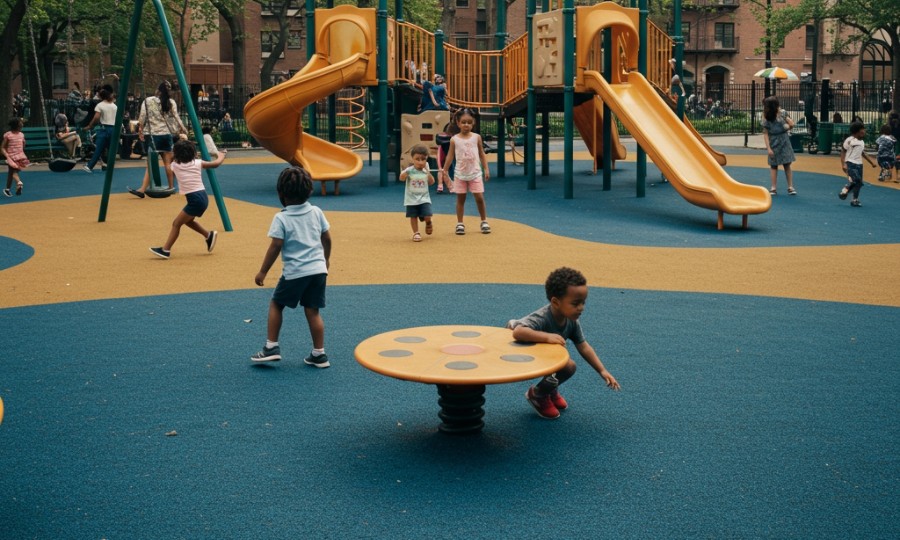
New York City offers incredible vibrancy and countless opportunities for families. In fact, its many parks and playgrounds stand as cherished havens for children to explore, learn, and grow. These spaces, however, also carry inherent risks. Unfortunately, playground accidents can happen, sometimes leading to serious injuries. As a trusted NYC personal injury law firm, RMFW Law understands the profound impact such incidents can have on families. Consequently, we believe in empowering parents and caregivers with vital information to prevent these occurrences. This comprehensive guide will therefore explore critical playground safety guidelines, helping ensure our children’s play remains both joyful and secure.
Ensuring the safety of our youngest New Yorkers is a shared responsibility. We must all understand the key elements that contribute to a safe play environment. From the ground beneath their feet to the equipment they climb on, every detail matters. Moreover, active adult involvement plays an indispensable role. Let’s delve into the specifics, providing clear, actionable insights for every parent, guardian, and community member.
The Foundation of Safety: Appropriate Playground Surfacing
One of the most crucial elements of playground safety lies directly beneath a child’s feet: the surfacing material. Falls are the leading cause of playground injuries, therefore, proper shock-absorbing surfaces are non-negotiable. Hard surfaces like asphalt, concrete, or packed earth offer no protection. Consequently, they greatly increase the risk of severe head injuries, fractures, and other critical harm.
NYC playgrounds typically utilize various types of safety surfacing. For instance, you might encounter wood chips, shredded rubber, sand, or synthetic turf. Each material has specific requirements for depth and maintenance to be effective. For example, wood chips or sand should be at least 12 inches deep for equipment up to 8 feet high. Similarly, rubber mats or poured-in-place rubber surfaces offer excellent shock absorption. However, they must meet specific critical fall height attenuation standards. Always check for adequate depth and consistency in these materials. Uneven spots or thin areas can quickly become dangerous.
Furthermore, inspect the area around swings and slides particularly closely. High-traffic zones tend to wear down faster. This creates depressions or exposes the hard ground underneath. A well-maintained surface significantly reduces the severity of injuries from falls. Parents should also look for proper drainage. Standing water can create slippery spots or even harbor mold and bacteria. Therefore, a dry, well-maintained surface is always safer.
Vigilance is Key: Regular Equipment Inspection
Playground equipment endures constant exposure to weather, wear, and tear. Therefore, consistent and thorough inspection is paramount. Many different entities maintain playgrounds in NYC, including the Department of Parks & Recreation, schools, and private organizations. Regardless of who owns it, parents and caregivers should always perform a quick visual check before allowing their children to play.
What should you look for during your inspection? First, check for any broken parts, such as cracked plastic, splintered wood, or bent metal. These can create sharp edges or unstable structures. Second, inspect for rust, especially on metal components like chains, bolts, or support beams. Rust weakens the equipment and can also cause tetanus if it scratches a child. Third, look for loose bolts, screws, or connections. Loose parts can cause equipment to collapse or create pinch points.
Furthermore, ensure that all S-hooks on swings are fully closed. Open S-hooks can easily snag clothing or skin, leading to serious injury. Similarly, check for any protruding bolts or sharp edges on slides or climbing structures. These can easily cut or scrape. Additionally, be aware of potential entanglement hazards. Ropes, nets, or even loose clothing can become caught, posing a strangulation risk. Report any identified hazards immediately to the appropriate authorities, such as NYC Parks by calling 311. Your quick action can prevent a future accident.
The Power of Presence: Importance of Adult Supervision
Even the safest playground equipment and surfacing cannot replace attentive adult supervision. Active supervision is not merely being present; it means constantly watching children, understanding their abilities, and intervening when necessary. For instance, avoid distractions like cell phones or conversations that take your attention away from the playing children. Their safety depends on your focused engagement.
Children, especially younger ones, often lack a full understanding of consequences. They may attempt stunts beyond their physical capabilities or wander into dangerous areas. Consequently, adults must guide them. Teach children about safe play practices, such as waiting their turn, not pushing, and using equipment appropriately. For example, instruct them to always sit down on slides and go feet first. Never allow them to climb up the slide itself.
Moreover, supervise children for age-appropriateness. Equipment designed for older children may pose hazards for toddlers. Conversely, older children might use equipment designed for younger kids in ways that make it unsafe. Always ensure your child is playing on structures suitable for their age and size. Furthermore, intervene if you see roughhousing or dangerous behavior among children, even if they are not your own. Everyone shares responsibility for playground safety. Your proactive approach can prevent many common playground injuries.
Navigating Environmental Hazards in NYC Playgrounds
Beyond equipment and supervision, environmental factors present significant risks, particularly in a dense urban environment like New York City. Awareness of these dangers can help prevent unexpected injuries.
Extreme Heat on Play Surfaces
One often-overlooked hazard is the extreme heat certain playground surfaces can reach, especially during NYC’s hot summer months. Dark-colored rubber surfacing, metal slides, and dark plastic can absorb sunlight and become dangerously hot. These surfaces can cause severe burns, particularly to young children with more delicate skin. Before allowing a child to play, always touch the surface first with your hand. If it feels too hot for your hand, it’s too hot for a child’s skin. Consider visiting playgrounds during cooler parts of the day or choosing those with shaded areas and lighter-colored materials.
Pinch Points and Entrapment Hazards
Playgrounds have many moving parts and gaps. These can create pinch points where fingers or limbs can get caught. For instance, look for gaps between moving components on swings or merry-go-rounds. Additionally, check for entrapment hazards. These are openings where a child’s head could get stuck but their body could slip through, leading to strangulation. Common culprits include gaps in guardrails, ladder rungs, or decorative elements. The U.S. Consumer Product Safety Commission (CPSC) provides specific guidelines for safe opening sizes. Therefore, any opening between 3.5 inches and 9 inches is potentially hazardous for head entrapment.
Weather Conditions and Debris
NYC weather can change rapidly. Consequently, rain or ice can make surfaces incredibly slippery, turning a fun play space into a treacherous one. Always check conditions before allowing play. Furthermore, urban environments sometimes present unexpected debris. Broken glass, discarded needles, sharp metal objects, or even animal waste can pose serious health and safety risks. Perform a quick visual scan of the entire play area before letting children roam freely. Teach children not to pick up unknown objects. Immediately report any dangerous litter to park staff or 311.
What to Do If an Accident Happens
Despite all precautions, accidents can still occur. If your child suffers an injury on an NYC playground, knowing what steps to take immediately can be crucial, both for their well-being and any potential legal claim.
First and foremost, attend to your child’s immediate medical needs. Provide first aid or seek emergency medical attention if necessary. Always prioritize their health. Second, if possible and appropriate, document the scene. Take photos or videos of the equipment, the surrounding area, and your child’s injuries. Note the time, date, and any witnesses present. Gather contact information from witnesses. Third, report the incident to the appropriate authorities, whether it’s NYC Parks staff, school officials, or the private owner of the playground. Obtain a copy of any incident report they create.
Finally, consider contacting an experienced New York City personal injury lawyer. At RMFW Law, we understand the complexities of playground injury cases. We can help you understand your rights, determine if negligence played a role, and pursue the compensation your child deserves for medical bills, pain, and suffering. We offer compassionate, clear guidance during a challenging time. Remember, you don’t have to navigate this alone. Our team is here to help you every step of the way.
Taking Confident Next Steps
Playgrounds are essential for children’s development, offering spaces for physical activity, social interaction, and imaginative play. By understanding and adhering to critical safety guidelines, we can collectively work towards making NYC playgrounds safer for everyone. Remember the importance of appropriate surfacing, diligent equipment inspection, active adult supervision, and awareness of environmental hazards. Your vigilance makes a difference.
Ultimately, your child’s safety is our highest priority. If you have questions about playground safety or if your child has been injured on a playground in New York City, please do not hesitate to reach out to RMFW Law. We are here to provide the warm, clear, and compassionate legal guidance you need. We can help you protect your family’s future.
Free Case Consultation
Injured in an accident? Contact Rosenberg, Minc, Falkoff & Wolff for a free and confidential case review with an experienced NYC personal injury attorney.
This article was drafted with AI assistance. Please verify all claims and information for accuracy. The content is for informational purposes only and does not constitute professional advice.


